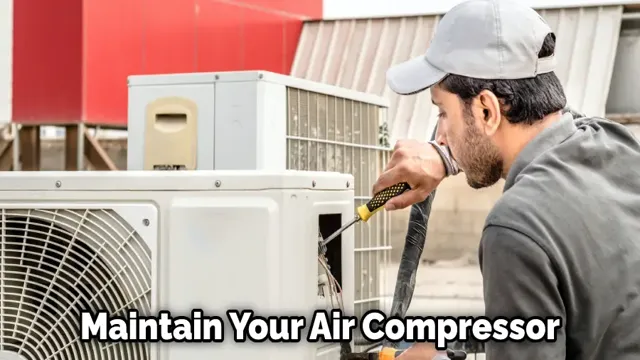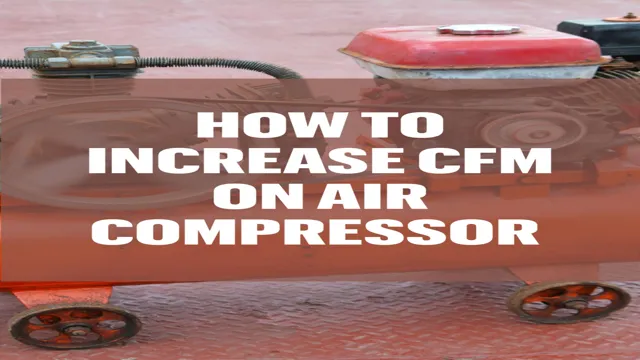
If you’re a regular user of an air compressor, you know that moisture build-up is an inevitable problem in the machine’s tank. Excess moisture in an air compressor tank can lead to rust and corrosion, which eventually damage the machine’s components, decrease its efficiency, and increase maintenance costs. Additionally, it can cause tools to clog or malfunction, ultimately, ruining your project.
That said, it’s crucial to take preventative measures to avoid the harmful effects of moisture build-up in your air compressor tank. In this blog, we’ll discuss some practical ways to prevent moisture in your air compressor tank and keep your machine functioning smoothly.
Understanding Moisture in Air Compressor Tanks
If you own an air compressor, you may notice that over time, moisture can accumulate inside the tank. This can lead to a range of issues, from reduced efficiency to damaged tools. Luckily, there are a few steps you can take to keep moisture out of your air compressor tank.
Firstly, it’s important to drain the tank regularly. This is especially important if you’ve been using the compressor for extended periods or in humid conditions. Additionally, you can invest in a moisture trap or separator, which will help to filter out any moisture that makes it into the tank.
Finally, you should make sure that your tank is properly sealed to prevent any moisture from seeping in from the outside. By taking these simple steps, you can help to keep your air compressor working effectively and extend its lifespan.
What Causes Moisture Buildup in Air Compressor Tanks
Air Compressor Tanks, Moisture Buildup Have you ever wondered why there is moisture buildup in your air compressor tanks? Well, the answer can be attributed to the laws of physics. When air is compressed, it becomes hot, causing it to hold more moisture. As the compressed air cools down, the moisture begins to condense and collect in the compressor tank.
This can cause several issues such as rust, corrosion, and decreased efficiency of the compressor. Moisture buildup can also lead to the growth of bacteria, which can contaminate the air being compressed. To prevent this, it is important to regularly drain and clean the compressor tank, and use accessories such as air dryers and filters to reduce moisture levels.
Proper maintenance can extend the life of your air compressor and ensure safe and efficient operation.

The Negative Effects of Moisture Buildup in Air Compressor Tanks
Moisture buildup in air compressor tanks is a common issue that can cause negative effects on the overall performance of your air compressor. Moisture is present in the air we breathe, even in low humidity environments. When the air is compressed, the moisture is also compressed, causing it to condense and collect in the bottom of the tank.
Over time, this moisture can build up and cause rust, corrosion, and damage to the tank and its components. This can lead to costly repairs and even total failure of the air compressor. It is essential to regularly drain the tank to prevent moisture buildup and avoid these negative effects.
Additionally, using a water trap or dryer can help remove moisture from the air before it enters the tank, further reducing the risk of moisture accumulation. By understanding the effects of moisture in air compressor tanks and taking preventative measures, you can ensure the longevity and proper functioning of your air compressor.
Ways to Keep Moisture Out of Air Compressor Tanks
If you’re dealing with rust or water buildup in your air compressor tank, you need to take steps to keep moisture out. One common way to do this is to use an air dryer. This device removes moisture from the compressed air before it enters the tank, preventing rust and other damage.
Another option is to drain the tank regularly. This involves opening the drain valve at the bottom of the tank and letting any water or condensation drain out. You should also check the tank for any leaks or holes that may be allowing moisture to enter.
Finally, consider investing in a stainless steel or aluminum tank. These materials are less susceptible to rust and corrosion than other metals, making them a great choice for heavy use. By taking these steps, you can keep your air compressor running smoothly and prevent costly repairs down the line.
Drain the Tank Daily
Air compressor tanks can quickly become a breeding ground for moisture if they are not properly maintained. One useful way to prevent this is to “drain the tank daily”. This simply involves opening the tank’s drain valve and allowing any accumulated moisture to escape.
Moisture can cause rust and corrosion, which can ultimately lead to the breakdown of the compressor. Beyond daily draining, there are other steps that can help keep moisture out of the tank. First, make sure the compressor is located in a dry and well-ventilated area.
Second, consider installing a moisture trap or filter to remove any water vapor from the air before it reaches the tank. Finally, check the tank’s pressure relief valve regularly to ensure it is working properly. By taking these measures, you can extend the life of your compressor and prevent costly repairs down the line.
Use an Air Dryer
One of the best ways to keep moisture out of your air compressor tank is by using an air dryer. An air dryer is designed to remove moisture from the air before it enters the tank. This can be especially important if your compressor is in an area with high humidity or if you use your compressor for applications that require dry air.
There are a variety of air dryers available, including refrigerated, desiccant, and membrane dryers. Refrigerated dryers work by cooling the air, which causes moisture to condense and be removed. Desiccant dryers use a special material to absorb moisture from the air.
Membrane dryers use a semi-permeable membrane to separate moisture from the air. No matter which type of air dryer you choose, it can help keep your compressor tank free from damaging moisture.
Install a Moisture Trap
If you’re looking to prevent moisture from building up in your air compressor tank, one of the most effective ways is to install a moisture trap. This handy device is designed to collect any excess moisture in the compressed air before it enters the tank, which can help prolong the life of your compressor and prevent costly repairs down the line. Moisture traps are easy to install and come in a variety of styles and sizes, so you can find one that fits your specific needs.
Plus, they’re relatively affordable and can last a long time with proper maintenance. By investing in a moisture trap, you can ensure that your air compressor is running at peak performance and avoid any problems that can arise from excess moisture in the tank. So if you want to keep your compressor in top shape, consider installing a moisture trap today.
Tips to Keep Moisture Out of Air Compressor Tanks
If you want to maintain your air compressor’s efficiency, it’s crucial to keep moisture out of your air compressor tank. Accumulated moisture in an air compressor tank can lead to rust, corrosion, and contamination of your air tools. One of the easiest ways to prevent moisture from entering your compressor tank is by installing a moisture trap.
This will effectively remove water from your air lines and stop it from entering your tank. Additionally, you should operate your compressor in a dry, cool environment and drain the tank regularly. Since moist air is denser than dry air, you should also ensure sufficient ventilation to allow moist air to escape.
It’s vital to follow these tips to keep your air compressor tank moisture-free and maintain its longevity and functionality.
Check for Leaks Regularly
One of the best ways to keep moisture out of air compressor tanks is to check for leaks regularly. You can start by inspecting the tank and all its components for any signs of damage, such as cracks, rust, or worn-out seals. Make sure that all fittings and connections are properly tightened and secured.
A leak can cause moisture to enter the tank, which can lead to rust and corrosion, reducing the lifespan of the compressor. In addition to visual inspections, you can also use a soapy water solution to check for leaks. Simply apply the solution to areas where leaks might occur and check for bubbling; bubbles indicate a leak.
Regular maintenance and checks are key to keeping moisture out of your air compressor tank and maintaining its longevity.
Maintain Your Air Compressor Properly
If you’re an air compressor user, you know the importance of keeping the tank dry. Moisture in the tank can cause rust and corrosion, leading to damage and expensive repairs. Here are some tips to keep your compressor tank moisture-free.
First, drain the tank daily to remove any condensate that may have collected. Install an automatic drain system to make it easier for you. Second, a dryer can be installed in the airline to extract excess moisture from the air stream.
Finally, keep the compressor in a warm, dry location as moisture is less likely to form in a low humidity environment. By following these simple steps, you can protect your air compressor tank and ensure it runs smoothly and efficiently.
Conclusion
So there you have it, keeping moisture out of your air compressor tank is all about prevention and monitoring. By using a proper drain valve, ensuring proper ventilation, and using a moisture trap, you can keep your compressed air dry and avoid any unwanted damage or maintenance costs. Remember, a dry tank is a happy tank, and a happy tank leads to happy compressions.
So keep it dry, keep it maintained, and keep those tools firing on all cylinders!”
FAQs
Why is moisture buildup in an air compressor tank a problem?
Moisture buildup in an air compressor tank can lead to corrosion, rust, and lower efficiency of the compressor. It can also cause problems with tools and equipment that are powered by the compressor.
What are some ways to prevent moisture buildup in an air compressor tank?
Some ways to prevent moisture buildup include regularly draining the tank, installing a moisture trap or filter, storing the compressor in a dry place, and using the compressor regularly to keep air circulating.
How often should I drain the air compressor tank?
It is recommended to drain the air compressor tank after every use to prevent moisture buildup. If the compressor is used frequently, it should be drained daily or weekly.
What type of moisture trap or filter should I use for my air compressor?
The type of moisture trap or filter you need depends on the size and type of your compressor. You can consult the manufacturer’s recommendations or a professional to determine the best option for your specific compressor.
Can I use a compressor with moisture in the tank?
It is not recommended to use a compressor with moisture in the tank as it can lead to damage to the compressor and tools or equipment that are powered by it.
How can I dry out the air compressor tank if it already has moisture buildup?
You can dry out the compressor tank by running the compressor with the drain valve open or using a compressed air dryer. It is also recommended to clean the tank to remove any rust or corrosion caused by the moisture buildup.
What other maintenance should I perform on my air compressor to prevent moisture buildup?
In addition to draining the tank regularly and installing a moisture trap or filter, you should also check for leaks in the air system, keep the compressor clean and free of debris, and check the oil level and change the oil as needed.







